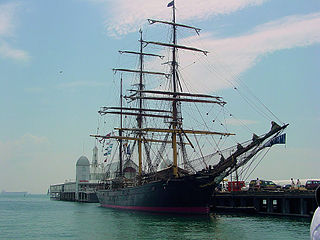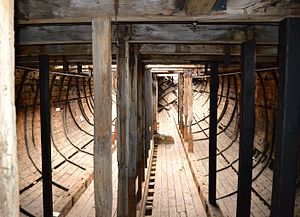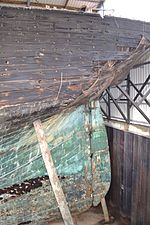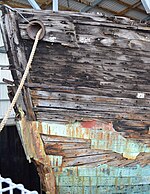
Star of India is an iron-hulled sailing ship, built in 1863 in Ramsey, Isle of Man as the full-rigged ship Euterpe. After a career sailing from Great Britain to India and New Zealand, she was renamed, re-rigged as a barque, and became a salmon hauler on the Alaska to California route. Retired in 1926, she was restored as a seaworthy museum ship in 1962–3 and home-ported at the Maritime Museum of San Diego in San Diego, California. She is the oldest ship still sailing regularly and also the oldest iron-hulled merchant ship still afloat. The ship is both a California Historical Landmark and United States National Historic Landmark.

Cutty Sark is a British clipper ship. Built on the River Leven, Dumbarton, Scotland in 1869 for the Jock Willis Shipping Line, she was one of the last tea clippers to be built and one of the fastest, at the end of a long period of design development for this type of vessel, which ended as steamships took over their routes. She was named after the short shirt of the fictional witch in Robert Burns' poem Tam o' Shanter, first published in 1791.

HMS Endeavour was a British Royal Navy research vessel that Lieutenant James Cook commanded to Tahiti, New Zealand and Australia on his first voyage of discovery from 1768 to 1771.

Thermopylae was an extreme composite clipper ship built in 1868 by Walter Hood & Co of Aberdeen, to the design of Bernard Waymouth of London. Designed for the China tea trade, she set a speed record on her maiden voyage to Melbourne of 63 days, still the fastest trip under sail.

A hulk is a ship that is afloat, but incapable of going to sea. Hulk may be used to describe a ship that has been launched but not completed, an abandoned wreck or shell, or to refer to a ship whose propulsion system is no longer maintained, or has been removed altogether. The word hulk also may be used as a verb: a ship is "hulked" to convert it to a hulk. The verb was also applied to crews of Royal Navy ships in dock, who were sent to the receiving ship for accommodation, or "hulked". Hulks have a variety of uses such as housing, prisons, salvage pontoons, gambling sites, naval training, or cargo storage.

James Craig is a three-masted, iron-hulled barque restored and sailed by the Sydney Heritage Fleet, Sydney, Australia.

Polly Woodside is a Belfast-built, three-masted, iron-hulled barque, preserved in Melbourne, Victoria (Australia), and forming the central feature of the South Wharf precinct. The ship was originally built in Belfast by William J. Woodside and was launched in 1885. Polly Woodside is typical of thousands of smaller iron barques built in the last days of sail, intended for deep water trade around the world and designed to be operated as economically as possible.

Peking is a steel-hulled four-masted barque. A so-called Flying P-Liner of the German company F. Laeisz, it was one of the last generation of cargo-carrying iron-hulled sailing ships used in the nitrate trade and wheat trade around Cape Horn.

The tall ship Elissa is a three-masted barque. She is based in Galveston, Texas, and is one of the oldest ships sailing today. Launched in 1877, she is now a museum ship at the Texas Seaport Museum. She was designated a National Historic Landmark in 1990. The Texas Legislature designated Elissa the official tall ship of Texas in 2005.

Moshulu is a four-masted steel barque, built as Kurt by William Hamilton and Company at Port Glasgow in Scotland in 1904. The largest remaining original windjammer, she is currently a floating restaurant docked in Penn's Landing, Philadelphia, adjacent to the museum ships USS Olympia and USS Becuna.

City of Adelaide is a clipper ship, built in Sunderland, England, and launched on 7 May 1864. It was built by Pile, Hay and Co. to transport passengers and goods between Britain and Australia. Between 1864 and 1887 she made 23 annual return voyages from London and Plymouth to Adelaide, South Australia and played an important part in the immigration of Australia. On the return voyages she carried passengers, wool, and copper from Adelaide and Port Augusta to London. From 1869 to 1885 she was part of Harrold Brothers' "Adelaide Line" of clippers.

DEV Arahura was a roll-on/roll-off train ferry that operated on the Interislander service between Wellington and Picton in New Zealand from 1983 until 2015.

HMS Buffalo was a storeship of the Royal Navy, originally built and launched at Sulkea, opposite Calcutta, in 1813 as the merchant vessel Hindostan. The Admiralty purchased her that year after she arrived in Britain. She later transported convicts and immigrants to Australia, before being wrecked in 1840.

Picton Castle is a tall ship used for deep-ocean sail training and long distance education voyages. The ship was the subject of the television series Tall Ship Chronicles which documented her second voyage around the world in 2001. The ship has carried out seven world voyages to date - completing the seventh one in 2019. While flagged in the Cook Islands, the ship's unofficial home port is Lunenburg, Nova Scotia.
Britannia may refer to any one of a large number of ships:

Hydrabad was an iron cargo and passenger sailing ship, built in Scotland and launched in 1865. She was owned by several successive companies, and served until being wrecked off the coast of New Zealand in 1878. There were attempts to salvage her, but they all failed, and the wreck was left to deteriorate on the shoreline.

Dom Fernando II e Glória is a wooden-hulled, 50-gun frigate of the Portuguese Navy. She was launched in 1843 and made her maiden voyage in 1845. Built at the shipyard of Daman in Portuguese India, it was Portugal's last sailing warship to be built and also the last ship that undertook the Carreira da Índia, a regular military line that connected Portugal to its colonies in India since the beginning of the 16th century.

The New Zealand Company was a 19th-century English company that played a key role in the colonisation of New Zealand. The company was formed to carry out the principles of systematic colonisation devised by Edward Gibbon Wakefield, who envisaged the creation of a new-model English society in the southern hemisphere. Under Wakefield's model, the colony would attract capitalists who would then have a ready supply of labour—migrant labourers who could not initially afford to be property owners, but who would have the expectation of one day buying land with their savings.

SB Pudge is a wooden Thames sailing barge, built in Rochester, Kent, England in 1922. Her hull was pitch pine on oak frame. She was originally spritsail rigged with bowsprit. An auxiliary oil engine made by The Bergius Co.Ltd of Glasgow was installed in 1932. She was used to carry various cargoes for the London & Rochester Trading Co until 1968, when she was bought out of trade by the Thames Sailing Barge Trust. Her last cargo was pineapple juice.





















